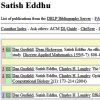| |
  
Dan Gusfield,
Dean Hickerson and
Satish Eddhu. An efficiently computed lower bound on the number of recombinations in phylogenetic networks: Theory and empirical study. In DAM, Vol. 155(6-7):806-830, 2007.
Note: http://wwwcsif.cs.ucdavis.edu/~gusfield/cclowerbound.pdf.
Toggle abstract
"Phylogenetic networks are models of sequence evolution that go beyond trees, allowing biological operations that are not tree-like. One of the most important biological operations is recombination between two sequences. An established problem [J. Hein, Reconstructing evolution of sequences subject to recombination using parsimony, Math. Biosci. 98 (1990) 185-200; J. Hein, A heuristic method to reconstruct the history of sequences subject to recombination, J. Molecular Evoluation 36 (1993) 396-405; Y. Song, J. Hein, Parsimonious reconstruction of sequence evolution and haplotype blocks: finding the minimum number of recombination events, in: Proceedings of 2003 Workshop on Algorithms in Bioinformatics, Berlin, Germany, 2003, Lecture Notes in Computer Science, Springer, Berlin; Y. Song, J. Hein, On the minimum number of recombination events in the evolutionary history of DNA sequences, J. Math. Biol. 48 (2003) 160-186; L. Wang, K. Zhang, L. Zhang, Perfect phylogenetic networks with recombination, J. Comput. Biol. 8 (2001) 69-78; S.R. Myers, R.C. Griffiths, Bounds on the minimum number of recombination events in a sample history, Genetics 163 (2003) 375-394; V. Bafna, V. Bansal, Improved recombination lower bounds for haplotype data, in: Proceedings of RECOMB, 2005; Y. Song, Y. Wu, D. Gusfield, Efficient computation of close lower and upper bounds on the minimum number of needed recombinations in the evolution of biological sequences, Bioinformatics 21 (2005) i413-i422. Bioinformatics (Suppl. 1), Proceedings of ISMB, 2005, D. Gusfield, S. Eddhu, C. Langley, Optimal, efficient reconstruction of phylogenetic networks with constrained recombination, J. Bioinform. Comput. Biol. 2(1) (2004) 173-213; D. Gusfield, Optimal, efficient reconstruction of root-unknown phylogenetic networks with constrained and structured recombination, J. Comput. Systems Sci. 70 (2005) 381-398] is to find a phylogenetic network that derives an input set of sequences, minimizing the number of recombinations used. No efficient, general algorithm is known for this problem. Several papers consider the problem of computing a lower bound on the number of recombinations needed. In this paper we establish a new, efficiently computed lower bound. This result is useful in methods to estimate the number of needed recombinations, and also to prove the optimality of algorithms for constructing phylogenetic networks under certain conditions [D. Gusfield, S. Eddhu, C. Langley, Optimal, efficient reconstruction of phylogenetic networks with constrained recombination, J. Bioinform. Comput. Biol. 2(1) (2004) 173-213; D. Gusfield, Optimal, efficient reconstruction of root-unknown phylogenetic networks with constrained and structured recombination, J. Comput. Systems Sci. 70 (2005) 381-398; D. Gusfield, Optimal, efficient reconstruction of root-unknown phylogenetic networks with constrained recombination, Technical Report, Department of Computer Science, University of California, Davis, CA, 2004]. The lower bound is based on a structural, combinatorial insight, using only the site conflicts and incompatibilities, and hence it is fundamental and applicable to many biological phenomena other than recombination, for example, when gene conversions or recurrent or back mutations or cross-species hybridizations cause the phylogenetic history to deviate from a tree structure. In addition to establishing the bound, we examine its use in more complex lower bound methods, and compare the bounds obtained to those obtained by other established lower bound methods. © 2006 Elsevier B.V. All rights reserved."
|
|
| |
  
Dan Gusfield,
Satish Eddhu and
Charles Langley. The fine structure of galls in phylogenetic networks. In INCOMP, Vol. 16(4):459-469, 2004.
Keywords: explicit network, from sequences, galled tree, phylogenetic network, phylogeny, reconstruction.
Note: http://wwwcsif.cs.ucdavis.edu/~gusfield/informs.pdf.
Toggle abstract
"A phylogenetic network is a generalization of a phylogenetic tree, allowing properties that are not tree-like. With the growth of genomic data, much of which does not fit ideal tree models, there is greater need to understand the algorithmics and combinatorics of phylogenetic networks (Posada and Crandall 2001, Schierup and Hein 2000). Wang et al. (2001) studied the problem of constructing a phylogenetic network for a set of n binary sequences derived from the all-zero ancestral sequence, when each site in the sequence can mutate from zero to one at most once in the network, and recombination between sequences is allowed. They showed that the problem of minimizing the number of recombinations in such networks is NP-hard, but introduced a special case of the problem, i.e., to determine whether the sequences could be derived on a phylogenetic network where the recombination cycles are node-disjoint. Wang et al. (2001) provide a sufficient, but not a necessary test, for such solutions. Gusfield et al. (2003, 2004) gave a polynomial-time algorithm that is both a necessary and sufficient test. In this paper, we study in much more detail the fine combinatorial structure of node-disjoint cycles in phylogenetic networks, both for purposes of insight into phylogenetic networks and to speed up parts of the previous algorithm. We explicitly characterize all the ways in which mutations can be arranged on a disjoint cycle, and prove a strong necessary condition for a set of mutations to be on a disjoint cycle. The main contribution here is to show how structure in the phylogenetic network is reflected in the structure of an efficiently-computable graph, called the conflict graph. The success of this approach suggests that additional insight into the structure of phylogenetic networks can be obtained by exploring structural properties of the conflict graph."
|
|
| |
  
Dan Gusfield,
Satish Eddhu and
Charles Langley. Optimal, Efficient Reconstruction of Phylogenetic Networks with Constrained Recombination. In JBCB, Vol. 2(1):173-213, 2004.
Keywords: explicit network, from sequences, galled tree, phylogenetic network, phylogeny, recombination, reconstruction.
Note: http://wwwcsif.cs.ucdavis.edu/~gusfield/exfinalrec.pdf.
Toggle abstract
"A phylogenetic network is a generalization of a phylogenetic tree, allowing structural properties that are not tree-like. In a seminal paper, Wang et al.1 studied the problem of constructing a phylogenetic network, allowing recombination between sequences, with the constraint that the resulting cycles must be disjoint. We call such a phylogenetic network a "galled-tree". They gave a polynomial-time algorithm that was intended to determine whether or not a set of sequences could be generated on galled-tree. Unfortunately, the algorithm by Wang et al.1 is incomplete and does not constitute a necessary test for the existence of a galled-tree for the data. In this paper, we completely solve the problem. Moreover, we prove that if there is a galled-tree, then the one produced by our algorithm minimizes the number of recombinations over all phylogenetic networks for the data, even allowing multiple-crossover recombinations. We also prove that when there is a galled-tree for the data, the galled-tree minimizing the number of recombinations is "essentially unique" . We. also note two additional results: first, any set of sequences that can be derived on a galled tree can be derived on a true tree (without recombination cycles), where at most one back mutation per site is allowed; second, the site compatibility problem (which is NP-hard in general) can be solved in polynomial time for any set of sequences that can be derived on a galled tree. Perhaps more important than the specific results about galled-trees, we introduce an approach that can be used to study recombination in general phylogenetic networks. This paper greatly extends the conference version that appears in an earlier work.8 PowerPoint slides of the conference talk can be found at our website. © Imperial College Press."
|
|
|
|
 - forked on GitHub.
- forked on GitHub.


